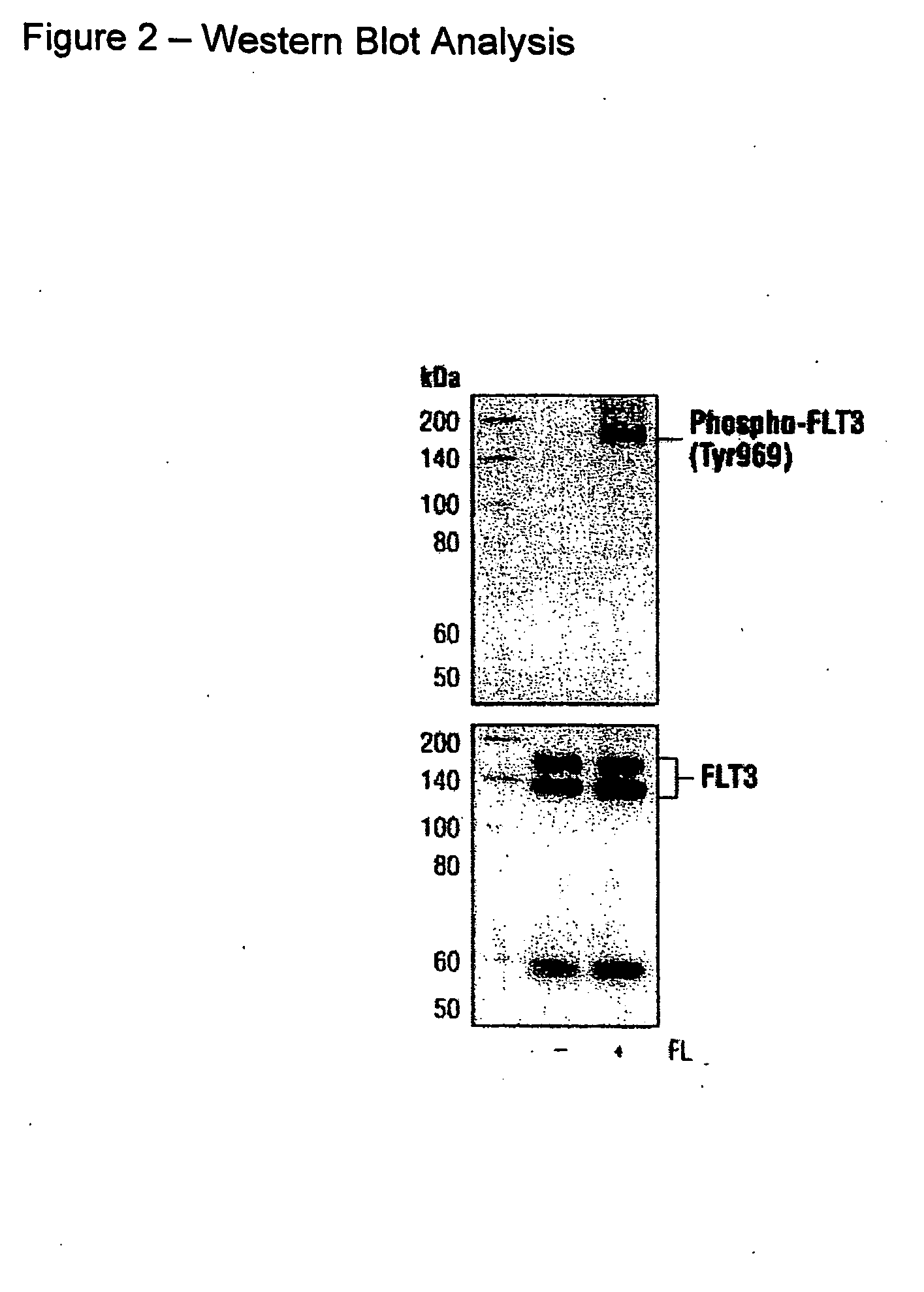Phospho-specific antibodies to flt3 (tyr969) and uses thereof
a technology of phospho-specific antibodies and receptor tyrosine kinases, which is applied in the field of antibodies, can solve the problems of uncontrolled growth and proliferation of cancerous cells, and the inability of flt3 expression alone to correlate with patients,
- Summary
- Abstract
- Description
- Claims
- Application Information
AI Technical Summary
Problems solved by technology
Method used
Image
Examples
example 1
Identification of the Flt3 (Tyr969) Phosphorylation Site by Global Phospho-Profiling
[0044]In order to discover previously unknown leukemia-related signal transduction protein phosphorylation sites, PhosphoScan® peptide isolation and characterization techniques were employed to identify phosphotyrosine- and / or phosphoserine-containing peptides in cell extracts from the following human Leukemia cell lines and patient cell lines: HT-93, KBM-3, SEM, KU-812, SUP-B15, BV-173, CMK, HEL, CLL-220, CLL-1202, CLL23LB4, MEC1, MEC2, MO1043, K562, EOL1, HL60, CTV-1, REH, MV4-11, PL-21, and MKPL-1; or from the following cell lines expressing activated BCR-Abl wild-type and mutant kinases such as: Baf3-p210 BCR-Abl, Baf3-M351 T-BCR-ABL, Baf3-E255K-BCR-Abl, Baf3-Y253F-BCR-Abl, Baf3-T315I-BCR-ABl, 3T3-v-Abl; or activated Flt3 kinase such as Baf3-FLT3. This work was first described by the present inventors in PCT / US06 / 00979 (Goss et al.), the disclosure of which is hereby incorporated herein in its en...
example 2
Production of a Flt3 (Tyr969) Phosphospecific Polyclonal Antibody
[0056]15 amino acid phospho-peptide antigens, PHTyQNRRPFSREMC (SEQ ID NO: 2) and CGRVSEAPHTyQNRR (SEQ ID NO: 3) (where y=phosphotyrosine), corresponding to residues 966-979 and 960-973, respectively, of human Flt-3 (SEQ ID NO: 1) plus cysteine on the C-terminal for coupling, were constructed according to standard synthesis techniques using a Rainin / Protein Technologies, Inc., Symphony peptide synthesizer. See ANTIBODIES: A LABORATORY MANUAL, supra.; Merrifield, supra.
[0057]These peptides were coupled to KLH, and rabbits are then injected intradermally (ID) on the back with antigen in complete Freunds adjuvant (500 μg antigen per rabbit). The rabbits were boosted with the same antigen in incomplete Freund adjuvant (250 μg antigen per rabbit) every three weeks. After the fifth boost, the bleeds were collected. The sera were purified by Protein A-affinity chromatography as previously described (see ANTIBODIES: A LABORATOR...
example 3
Production of a Flt3(Tyr969) Phosphospecific Monoclonal Antibody
[0060]A Flt3 (Tyr969) phosphospecific rabbit monoclonal antibody, C24D9, was produced from spleen cells of the immunized rabbit described in Example 2, above, following standard procedures (Harlow and Lane, 1988). The rabbit splenocytes were fused to proprietary fusion partner cells according to a proprietary protocol (see generally Loyola School of Medicine protocol (Helga Spieker-Polet) at http: / / www.meddean.luc.edu / lumen / DeptWebs / microbio / KNIGHT / PROTO C / Hybridom.htm.)
[0061]Colonies originating from the fusion were screened by ELISA for reactivity to the phospho-peptide and non-phospho-peptide and by Western blot analysis. Colonies found to be positive by ELISA to the phospho-peptide while negative to the non-phospho-peptide were further characterized by Western blot analysis. Colonies found to be positive by Western blot analysis were subcloned by limited dilution. Mouse ascites were produced from the single clone ob...
PUM
 Login to View More
Login to View More Abstract
Description
Claims
Application Information
 Login to View More
Login to View More - R&D
- Intellectual Property
- Life Sciences
- Materials
- Tech Scout
- Unparalleled Data Quality
- Higher Quality Content
- 60% Fewer Hallucinations
Browse by: Latest US Patents, China's latest patents, Technical Efficacy Thesaurus, Application Domain, Technology Topic, Popular Technical Reports.
© 2025 PatSnap. All rights reserved.Legal|Privacy policy|Modern Slavery Act Transparency Statement|Sitemap|About US| Contact US: help@patsnap.com


